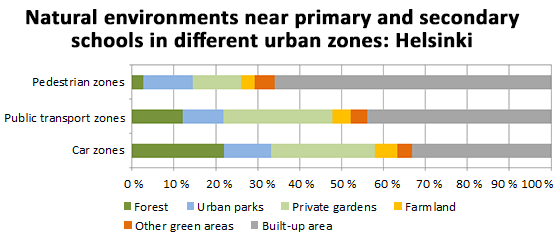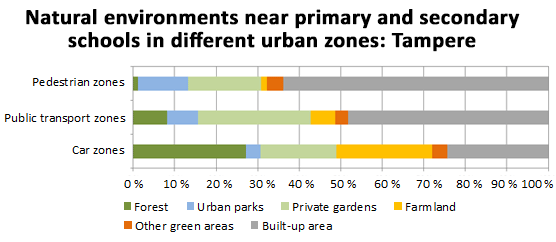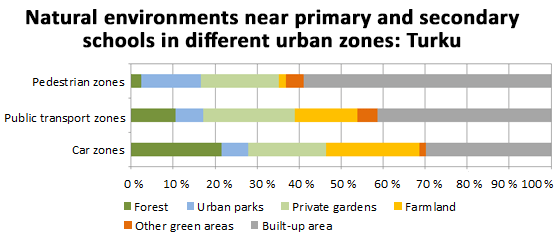Education supports the achievement of all of the goals of sustainable development put forward by the UN. According to the goal of education for sustainable development, all students on a global scale should achieve the kind of knowledge and skills that will enable them to secure sustainability of the environment and the implementation of human rights.

© Picture: Marianna Korpi
In Finland day care centres and schools have an important role in achieving the goal. According to early education and basic teaching curricula, schools support a sustainable lifestyle while encouraging children and young people to have a relationship with nature.
The experiences that children and young people have with nature are linked with environmentally responsible behaviour. When it is established in childhood, a positive relationship with nature affects environmentally responsible behaviour also as an adult (Chawla 1990, Evans et.al. 2018). This is why day care centres and schools should provide environmental education in a natural environment. Nature is a good and versatile learning environment. Learning in nature also supports the development of social, academic, and motor skills (Fjørtoft 2001; Rickinson et.al. 2004).
Time spent in nature promotes health
Time spent in nature is also important for the health and well-being of children and young people. Contacts with nature diversify the microbes in the body and strengthen immune defence. Good microbes and immune defences protect against inflammatory diseases such as asthma and atopic skin conditions. Recent studies support this biodiversity hypothesis of health. In addition, being in nature is refreshing and revitalising, while comprehensively promoting physical and psychological well-being. Being in nature also has a calming effect, as it lowers the level of cortisol, the stress hormone.
It is especially important for children to be exposed to microbes in nature. Increasing numbers of children live in urban environments. For that reason the importance of green areas in cities and urban forests has grown in the exposure of children to nature. Nature areas need to be included in the proximity of schools so that children and young people can have easy and regular access to nature. According to recommendations of the Ministry of the Environment the distance to a green area should be no more than 300 metres.
The more diverse the nature of a green area is, the more versatile its benefits. It would be important for there to be forests in the proximity of schools and day care centres. The Finnish Environment Institute has analysed the distances from day care centres in the Helsinki region (1020 locations) to green areas. About half of the day care centres in the Helsinki region are located more than 300 metres from a forest. However, there are parks near most day care centres.
Two out of five primary schools are more than 300 metres from a forest
It is worthwhile for schools to regularly make use of nearby green areas. This promotes health and well-being for children and young people. In the best of cases nearby nature is made a part of the curriculum.
A new analysis has studied the distance between schools and green areas. Under examination were primary and secondary schools in the Helsinki region as well as the urban areas of Tampere and Turku.
Primary school pupils move independently only within a fairly small area. That is why there should be green areas especially near primary schools.
According to the study primary schools do tend to be located closer to forests than secondary schools. However, in all areas that were analysed about 40 percent of primary schools are located at a distance of more than 300 metres from a forest.
Secondary schools further from forests in Tampere and Turku
There were greater differences between different urban regions in distances of secondary schools from forests. In the Helsinki region 38 percent of secondary schools are located at a distance of more than 300 metres from a forest. In the regions of Tampere and Turku there were considerably more of these schools that are located further from the forest: Of the secondary schools in the Tampere area 64 percent, and 58 percent of those in the Turku region area located more than 300 metres from a forest.
Some green areas can be found near most schools. Only 11 of all primary schools analysed (383) are not located in the vicinity of a forest or park. Three of these schools are in the Helsinki region, and two in the Tampere, and six in the Turku regions. Of all of the secondary schools analysed (174) only one school in the Turku area was also at a distance of more than 300 metres from a park.
Land use near schools varies
Land cover was also analysed in all three urban areas. The analysis differentiated between schools in the zones with differing community structures.
A built-up environment can be divided according to community structure into pedestrian, public transport, and car zones. The zones are based on the distance of each area from the city centre and the possibilities for movement. Green areas are also part of these zones. Different zones have different kinds of possibilities to support exposure to nature that promotes health.
In all of the analysed urban areas, the pedestrian zone has the greatest number of built-up areas and the least forest and other green areas. However this zone also had the largest number of schools. This should be taken into consideration in urban planning in order to ensure that pupils in the pedestrian zone also have enough access to green areas, which promote health, well-being, and enjoyment.

Natural environments near primary and secondary schools in different urban zones: Helsinki.

Natural environments near primary and secondary schools in different urban zones: Tampere.

Natural environments near primary and secondary schools in different urban zones: Turku.